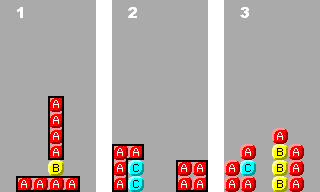Puyo Puyo
|
|
Puyo Puyo is a 1991 computer puzzle game by Compile. Some use it as the generic name of its concept, the way Tetris may be applied to a Tetris-like clone. There are many different games with the same concept under a variety of different names, though most of Compile's implementations have the word Puyo at least once in the title.
| Contents |
Gameplay
Two pieces, called Puyos in Compile's implementations, fall from the top of the screen in a pair. The pair can be moved left and right and rotated into one of four configurations. The pair drops until one piece falls onto another piece or the bottom of the screen. The pair then breaks, so the other piece is free to fall until it falls onto another piece or the bottom of the screen.
Groups
Four pieces. of the same color form a group when they are connected horizontally and/or vertically; diagonal connections do not count. They need not lie in a straight row or column. For example, the A pieces form groups in grids 1 and 2, but not 3:
When four or more pieces are connected in a group, they disappear. All pieces above those pieces then fall until they land onto other pieces or the bottom of the screen.
Combos
A combo is made when either more than four pieces form a group or more than one group is formed at one time. All the pieces in a combo are cleared at one time. For example, grid 4 has a 5 combo, grid 5 has two groups of 4 for an 8 combo, and grid 6 has 3 groups of 5 for a 15 combo:
Missing image
Puyo-combos.png
Image:Puyo-combos.png
Chains
A chain is made when a group is formed after pieces fall into a space where a group was cleared; i.e., gravity forms a group. After that group clears, gravity kicks in again, making chains of length 3, 4, 5, and so on possible. For example, grid 7 will form a 2 chain, grid 8 will form a 3 chain, and grid 9 will form a 5 chain:
Missing image
Puyo-chains.png
Image:Puyo-chains.png
Losing
The regulation-size Puyo Puyo playing field is 6 pieces wide and 12 pieces high. If a piece reaches the top in the third column from the left of a player's grid (or in Puyo Puyo Fever, the third or fourth column), that player loses. Pieces can reach the top of the two end columns on either side, though.
Opponents
The main game of Puyo Puyo is played against at least one opponent, computer or human. Whenever a player completes a chain or combo, garbage pieces are dropped onto all the other players; the larger the chain or combo, the more pieces are dropped. These garbage pieces cannot be formed into groups. The only way these pieces can be cleared is by clearing normal pieces next to them. A player wins when all the other players have lost.
Brief History
Puyo Puyo was originally released by Compile in 1991 for the MSX2 under the name Puyo Puyo. It was soon followed by a version for the Famicom Disk System called Puyo Puyo Disk Drive. Puyo Puyo featured characters from the 1989 RPG Madou Monogatari, also made by Compile. Puyo were enemy monsters in the Madou Monogatari game. They were the rough equivalent of the slime monsters from the Dragon Quest game series.
Puyo Puyo only really became popular when it was released as an arcade game in 1992. This was the first version that included a one player story mode, in which the human player plays against computer opponents of increasing difficulty. This feature was an immediate success because it allowed players to play by themselves. Future versions of Puyo Puyo for console systems also included this feature.
Many versions of Puyo Puyo have been released for many different systems, including MSX2, Super Famicom/SNES, Sega Mega Drive/Sega Genesis, Game Gear, Game Boy, Nintendo 64, Windows, Macintosh, et al. However, most of these ports were only released in Japan.
Of the ports actually released in the United States, most have non-Puyo names: Kirby's Avalanche (SNES), Dr. Robotnik's Mean Bean Machine (Sega Genesis in North America and Sega Mega Drive in Europe, which also had an 8-bit release), and Candy Crisis, to name a few. There are exceptions, however, such as Puyo Pop for the Game Boy Advance.
Puyo Puyo Fever (Puyo Pop Fever outside of Japan) was the last game released by Sega for its Dreamcast system. It was also ported to the Xbox, PlayStation 2, GameCube, Game Boy Advance and Nintendo DS platforms.
External links
- Puyo Puyo Flash (http://www.cruddog.com/puyopuyoflash/), an on-line version of Puyo Puyo made in Macromedia Flash
- Candy Crisis (http://www.candycrisis.com/), the homepage for a Mac version of Puyo Puyo
- Hardcore Gaming 101 - Puyo Puyo (http://www.classicgaming.com/reviews/puyo/puyopuyo.htm) - details the entirety of the series and all of its spinoffsfr:Puyo Puyo

